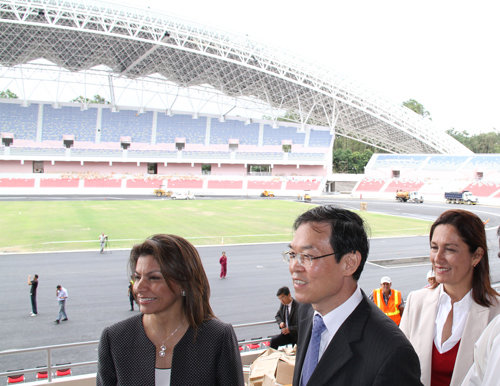|
 |
|
A NEW LANDMARK: Costa Rican President Laura Chinchilla Miranda (left), accompanied by China's Ambassador to Costa Rica Li Changhua (second left), visits the National Stadium donated by China in San Jose, capital of Costa Rica, on October 14, 2010 (YU HONGXIA) |
In the meantime, their bilateral trade witnessed quick growth. China's official statistics show trade between China and Costa Rica reached $3.8 billion in 2010, up 19.2 percent over the previous year. Costa Rica's exports to China amounted to $3.11 billion. China has become the second largest trade partner of Costa Rica.
Located in the heart of Central America, Costa Rica enjoys a booming economy and a stable political environment. Given its regional political and economic influence, it is in a position to become China's most important partner in Central America. The development of Sino-Costa Rican relations could prompt other Central American countries that have yet to establish diplomatic relations with China, such as Nicaragua, El Salvador, to build stronger ties with China.
Costa Rica regards China as an important strategic partner. China is not only the biggest purchaser of the Intel chips—Costa Rica's No.1 export product, but also a potential big consumer of its beef, bananas and other agricultural products. According to official statistics of Costa Rica, exports to China accounted for 50 percent of Costa Rica's total exports to Asia in 2009 and 8.07 percent of its total foreign exports in 2010. Costa Rica is China's fourth biggest source of flower imports. Seven percent of China's imported flowers come from Costa Rica.
Investment surge
The implementation of the FTA between China and Costa Rica will greatly promote the economic and trade cooperation between China and the whole Latin American region. In recent years, China has shown an interest in investment in Latin America. According to the Economic Commission for Latin America and the Caribbean, Chinese enterprises altogether invested nearly $47 billion in Latin American countries in 2010 through direct investment, mergers and acquisitions.
The focus was on South American countries rich in resources. Brazilian statistics show China's contractual and paid-in investment in Brazil totaled $17 billion in 2010, making Brazil China's top investment destination in Latin America.
China's Sinopec Group purchased a 40-percent stake in Spanish oil and gas company Repsol's Brazilian unit with $7 billion in 2010. The China National Offshore Oil Corp. (CNOOC) and the China National Chemical Corp. also conducted large-scale acquisitions in Brazil's petrochemical industry. In addition, Chinese companies in car making, agriculture and equipment manufacturing have benefited greatly from investment in Brazil.
In Argentina, CNOOC purchased a 50-percent stake in Argentina's oil and gas company Bridas and a 100-percent stake in its second largest oil producer Pan American Energy. Chinese companies' heavy investments in energy and mining have helped push forward Argentina's economic growth.
Peru and Ecuador have also become Chinese companies' key partners with their aluminum, copper and oil reserves.
In the meantime, China has demonstrated a tremendous interest in importing Latin America's high value-added products, such as Brazil's regional aircraft, Cuba's biomedical products and Chile's mineral extraction technology.
However, there are also discords in Sino-Latin American relations. Argentina, Brazil and other countries continue to conduct anti-dumping investigations, trade remedies and other protectionist actions against Chinese products, while exaggerating Chinese products' impact on local industries.
Many countries including Brazil are worried about Chinese companies' purchasing land and mines in their countries. Trade unions and local communities in Peru and Ecuador adopt an unfriendly attitude toward foreign investors. These factors are constraining the development of Sino-Latin American economic and trade relations.
Against this backdrop, signing FTAs has become the best way of ensuring the interests of both sides. This is also partly why China has accelerated free trade negotiations with Latin American countries in recent years. The newly implemented Sino-Costa Rican FTA will definitely enhance other Latin American countries' interest in launching free trade negotiations with China.
The author is an associate research fellow with the China Institutes of Contemporary International Relations
Key Figures
Trade between China and Costa Rica reached $3.8 billion in 2010, up 19.2 percent over the previous year. Costa Rica's exports to China totaled $3.11 billion.
Exports to China accounted for 50 percent of Costa Rica's total exports to Asia in 2009 and 8.07 percent of its total foreign exports in 2010.
Chinese enterprises altogether invested nearly $47 billion in Latin American countries in 2010 through direct investment, mergers and acquisitions. | 